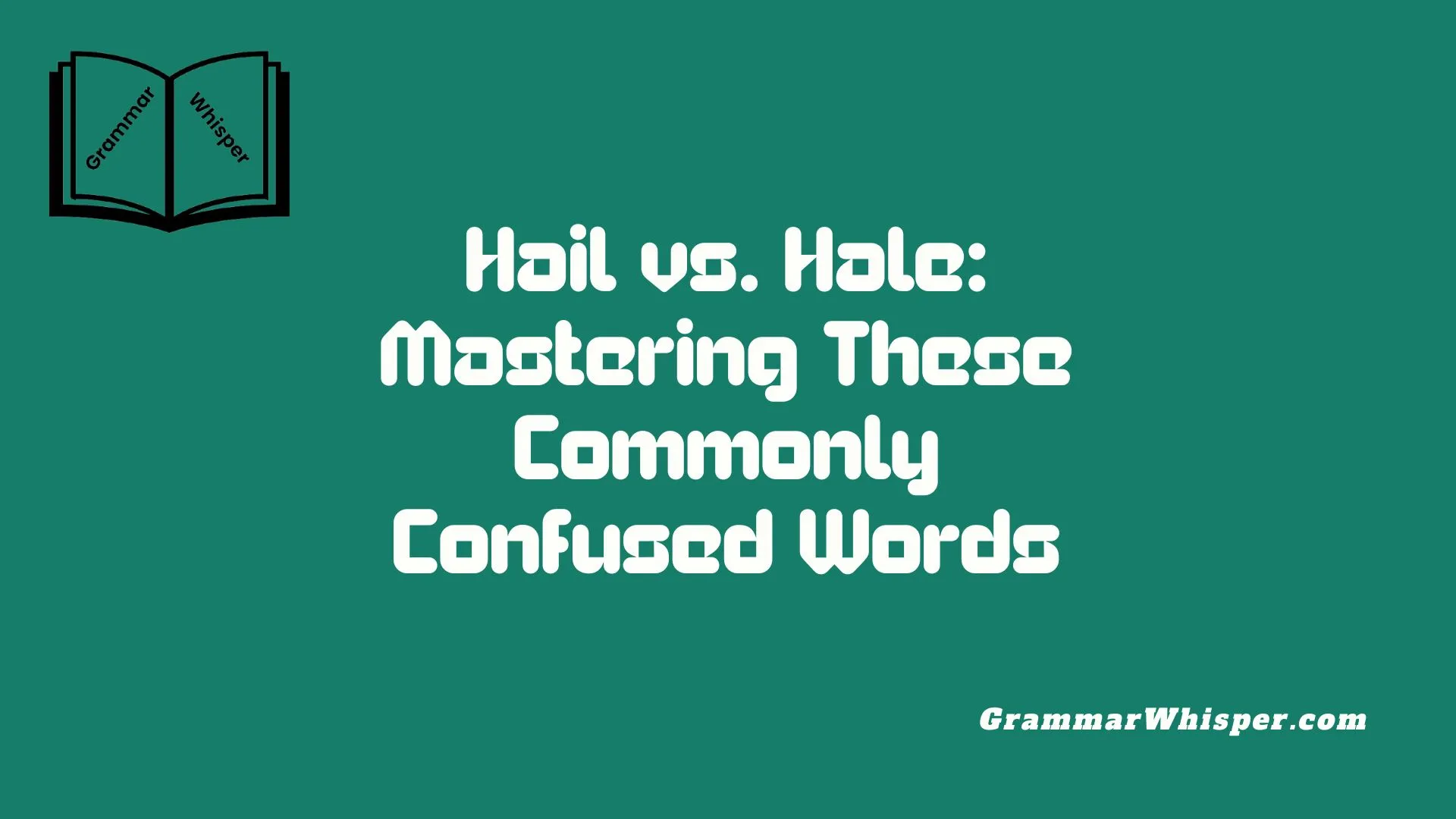In English, there are many commonly confused words that present challenges even for fluent speakers. A clear case is Hail vs. Hale – both tricky homophones that sound alike but carry different meanings, spellings, and origins. I’ve seen students often pause, sometimes mid-sentence, feeling unsure about which one to use. This pair is a frequent stumbling block in both speech and writing. But once you understand what sets them apart, mastering their usage becomes much easier. From what I’ve taught over the years, I know how quickly people can gain confidence through learning just one simple trick.
Every article I write or lesson I teach includes real-world examples and helpful memory tricks – they really do make a difference. If you learn to connect “hale” with health (as in “hearty and hale”), and “hail” with falling ice or a loud greeting (“hail a cab” or “hail from a place”), you won’t mix them up again. The difference becomes natural. So, the next time you’re writing or speaking, you’ll be able to use the words correctly – every time. That’s the real key to overcoming words that often trip people up. Once you understand this clearly, you’ll own it for life.
What Makes Hail vs. Hale a Headache?
First, let’s understand why hail and hale are confused:
- Pronunciation identical: both spoken as /heɪl/.
- One-letter difference, but a world of meaning apart.
- Diverse usage: hail can be weather‑related or verbal; hail is an adjective describing health.
- Misuse is common, even among native speakers.
You’ve likely seen “hail” when reading weather reports, or “hale” in “hale and hearty at 80.” But knowing which to use and when makes all the difference in clarity and tone.
Homophones 101: Why Do They Matter?
Homophones – words that sound the same but differ in meaning and spelling – populate English. They often lead to confusion and miscommunication. Imagine reading, “We had a great hike in the hills,” when the writer meant “high.” Though small, the error interrupts the flow and weakens credibility.
Common homophone pairs include:
- Bare vs. Bear
- Their vs. There vs. They’re
- Air vs. Heir
But Hail vs. Hale is special. One deals with weather or greeting, the other with vitality. Mixing them can twist the meaning entirely.
Hail: Many Faces of a Single Word
Hail as Frozen Precipitation
- Definition: Frozen raindrops forming small balls or chunks during thunderstorms.
- How it forms: Updrafts in storm clouds carry raindrops upward into cold regions, freeze them, and bring them back down. Repeat, and hailstones grow.
- Size matters:
- Pea size: ~0.2 inches (5 mm)
- Marble to golf ball size: up to 1.75 inches (44 mm)
- Baseball size or larger: extremely rare and damaging.
Table: Hail Size & Damage
| Size Range | Diameter | Effect |
| Pea–marble | 0.2–0.6 in | Minimal – little to no damage |
| Golf ball | 1.75 in | Can dent cars, damage roofs & crops |
| Baseball size | ~2.75 in | Major damage to vehicles, homes, and the greenhouse |
| Larger | 3–6 in | Rare, kite-sized hail has shattered windows in rare storms |
Interesting fact: The largest hailstone in the U.S. weighed 1.7 pounds (about 0.77 kg) and dropped in Vivian, South Dakota, on July 23, 2010.
Beyond size, hail can injure animals or people and temporarily interrupt travel.
Hail as a Verb: Greet, Summon, or Praise
Hail also functions as a verb with several uses:
- To call out or summon: “Hail a taxi!” Or “She stood on the curb, hailing cabs.”
- To greet or acclaim: “All hail the queen!” It’s used formally – royalty, heroes, or ceremonial praise.
- To indicate origin: “He hails from Paris.” Simply put: “He’s from Paris.”
Figurative and Formal Use of Hail
In literature, speeches, and older writing, hail carries a tone of celebration or call to attention:
“Hail Caesar!”
This usage dates back to at least the 1st century BC. It’s ceremonial and powerful – a reminder that words carry emotional weight.
Hale: Not Weather, but Wellness
In contrast, hale is narrow in meaning but rich in context:
- Definition: Describes someone (or an older person) as strong, healthy, and in good condition.
- Usage frequency: Still common in phrases like “hale and hearty,” especially describing elderly people who remain spry.
- Example: “At 95, she’s still hale and hearty.”
Brief origin: Comes from Old English hal, meaning whole, healed, or uninjured. It’s related to the word health.
Hail vs. Hale: At-a-Glance Comparison
| Word | Part of Speech | Definition | Example |
| Hail | Noun | Small balls of ice from storms | “That hail damaged the windshield.” |
| Verb | Greet, summon, or acclaim | “Let’s hail a cab.” / “Hail the hero!” | |
| Hale | Adjective | Robust, healthy, physically strong | “He’s hale and hearty at 90.” |
This table showcases the essentials. Keep it handy as a quick reference.
Seeing the Mistakes: Real-Life Misuses and Corrections
We all slip sometimes. Here are real-world examples (with names anonymized) where hail and hale get swapped – and a fix:
Mistake
“She was hale from Ohio.”
Issue: “Hale” is health-related; here, they meant place of origin.
Fix
“She hails from Ohio.”
Mistake
“We watched the hail game.”
Issue: Likely refers to “hell” or “he’ll.” If they meant “hail,” it makes little sense.
Fix
If weather context: “We watched the hailstorm.” If greeting: “We watched him hail a taxi.”
Mini Quiz (So You Can Check Yourself)
Fill in the blanks with hail or hale:
- “After the storm, ____ fell in chunks the size of golf balls.”
- “At 85, she’s still ____ and hearty.”
- “We stood on the sidewalk waiting to ____ a taxi.”
- “All ____ the new principal!”
Answers: hail, hale, hail, hail. Did you get them all? Great!
Tricks to Keep Hail vs. Hale Straight
1. Mnemonics That Work
- Hail = Ice: Hail has an “i,” just like ice.
- Hale = Health: Both start with “h‑ea.”
2. Visual Flashcards
- On one side: “Hail ☂️”
- On the other: “Hale = strong 💪”
3. Analogies
- Hail is like raindrops with attitude – solid, loud, and sometimes painful.
- Hale is calm and steady, ike an older tree that remains sturdy and tall.
4. Practice Sentence List
Try these:
- “I hail from Texas.”
- “After that storm, hail shattered my windows.”
- “She’s hale and hearty even at 100.”
Why Context Is Key
When speaking or listening, context tells you which word to use.
- Weather-related words nearby? Likely “hail.”
- Adjectives about health? That’s hale.
- Formal greeting or summoning? You’ve got hail.
Writers: proofread carefully. Tools like Grammarly may miss homophones. Read aloud, and your ear will catch the mistake.
Favorite Expressions With Hail or Hale
- Hail Mary (pass) – In football, a desperate, long throw near game end.
- Hail and hearty – Picture a smiling nonagenarian on a bicycle.
- All hail – A cheer before a royal ceremony or celebration.
Each phrase carries tradition and flavor that dates back centuries.
How to Use Hail vs. Hale in Writing & Speaking
Here are straightforward tips:
- Proofread slowly, focusing on these words.
- Read aloud: Hearing the words helps catch context mismatch.
- Context check: If you mention storms or health, double-check which fits.
- Teach others: Try explaining the difference to a friend – it sticks better.
Conclusion:
Understanding the difference between hail and hale is more than just a grammar fix – it’s a key to clearer communication. While they sound the same, these homophones serve entirely different purposes. Hail refers to icy precipitation or acts of greeting, calling, or celebrating. Hale, on the other hand, is all about strength and health, especially in older adults.
By mastering these distinctions, you’re not just improving your writing – you’re showing command over the language. Whether you’re penning an email, writing a blog post, or chatting casually, using the right word leaves a sharp impression. Rely on context clues, memory tricks, and this guide as your go-to resource.
Next time you see a weather alert or hear someone praise an elder for being “hale and hearty,” you’ll know exactly what they mean – and why it matters.
FAQs:
What is the difference between ‘hail’ and ‘hale’?
Hail can mean frozen rain or an act of calling or greeting. Hale is an adjective that describes someone, especially an older person, as healthy and robust. While they sound alike, they have different meanings and spellings.
Is ‘hale’ still used in modern English?
Yes. Though less common, hale still appears in phrases like “hale and hearty,” especially in formal writing or descriptions of well-being in older individuals.
Can ‘hail’ be used as both a noun and a verb?
Absolutely. As a noun, it refers to icy pellets from the sky. As a verb, it means to greet, summon, or recognize someone or something (“hail a cab” or “hail the king”).
How can I quickly remember the difference between the two?
Use this memory trick:
- Hail has an “i”, like ice.
- Hale sounds like heal, which relates to health.
Are there other homophones like ‘hail’ and ‘hale’?
Yes, plenty! Examples include:
- Their / there / they’re
- Bare / bear Pour/poree These words all sound the same but have different meanings and spellings – so they trip up even fluent English speakers.











